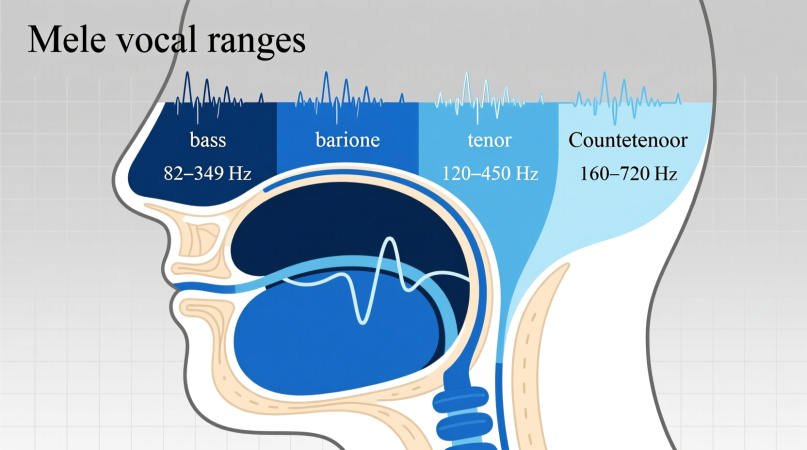
When we talk about male singers, we often hear terms like tenor, baritone, or bass. These categories describe different male vocal ranges—the span between the lowest and highest notes a singer can produce.
Knowing your vocal range helps you pick the right songs, protect your voice from strain, and discover the repertoire that best fits your natural sound. In this guide, we’ll break down the main male ranges, how they differ, and how to figure out where your own voice sits.
Why Male Vocal Ranges Matter
Your range isn’t just a technical measurement—it’s the foundation of your singing identity. It influences:
- Song choice: Singing outside your range can cause damage.
- Choir/ensemble role: Determines if you sing lead, harmony, or support.
- Comfort: Staying within your natural tessitura (the range where your voice feels most at ease) reduces strain.
- Artistry: Knowing your range lets you explore the full color of your voice.
The 4 Main Male Vocal Ranges
While each singer is unique, male voices are generally grouped into four categories: countertenor, tenor, baritone, and bass.
Countertenor – The Rare High Male Voice
- Typical Range: G3 to D5/E5 (sometimes higher, reaching C6)
- Timbre: Light, bright, often uses falsetto or reinforced head voice
- Famous Examples: Andreas Scholl, Klaus Nomi, and in pop music, singers like Prince used countertenor qualities.
The countertenor is the least common male vocal type. In classical music, they often sing parts originally written for castrati. In modern music, they add unique flair with soaring, almost soprano-like tones.
Tenor – The High Male Range
- Typical Range: C3 to C5
- Timbre: Bright, ringing, emotional
- Subtypes: Lyric, dramatic, spinto, heldentenor (opera)
- Famous Examples: Luciano Pavarotti, Freddie Mercury, Sam Smith
Tenors are known for carrying melodies and hitting powerful high notes. They dominate pop and classical music alike. Their emotional expressiveness often makes them crowd favorites.
Baritone – The Most Common Male Voice
- Typical Range: A2 to A4 (sometimes wider, F2 to G4)
- Timbre: Warm, versatile, flexible between highs and lows
- Famous Examples: Elvis Presley, Frank Sinatra, Josh Groban
Baritone voices cover a wide middle ground. They can reach down into bass notes and push up into tenor territory. Because of this versatility, baritones are the most common male voice type.
Bass – The Deepest Male Range
- Typical Range: E2 to E4 (sometimes down to C2)
- Timbre: Dark, rich, resonant
- Famous Examples: Barry White, Johnny Cash, Avi Kaplan (Pentatonix)
Basses provide the foundation of vocal ensembles. Their deep resonance gives music power and depth, whether in opera, choir, or modern acapella.
Quick Comparison Table of Male Vocal Ranges
| Range | Notes (Typical) | Famous Examples | Characteristics |
|---|---|---|---|
| Countertenor | G3 – D5/E5+ | Prince, Andreas Scholl | Rare, high, soprano-like |
| Tenor | C3 – C5 | Freddie Mercury, Sam Smith | Bright, emotional, high |
| Baritone | A2 – A4 | Elvis Presley, Frank Sinatra | Common, warm, versatile |
| Bass | E2 – E4 | Barry White, Johnny Cash | Deep, resonant, powerful |
Tessitura vs. Range: Why Comfort Matters
A key point often overlooked is the difference between range and tessitura:
- Range: The absolute lowest and highest notes you can hit.
- Tessitura: The part of the range where your voice is most comfortable.
Example: A baritone may be able to sing a high C once in a while, but their tessitura lies lower, making baritone roles more natural.
Male Vocal Ranges in Different Genres
- Opera/Classical: Strictly categorized—tenors sing hero roles, baritones play leaders, basses bring gravitas.
- Pop/Rock: More flexible. Freddie Mercury (tenor) stretched into baritone range, while Kurt Cobain (baritone) often sang higher.
- Jazz/Soul: Basses like Barry White and Isaac Hayes defined whole genres with their depth.
How to Find Out Your Male Vocal Range
Want to know if you’re a tenor, baritone, or bass? Try this:
- Warm up your voice with humming or scales.
- Start from middle C (C4) and sing down slowly until your voice cracks—note your lowest pitch.
- Return to C4 and sing upward until you strain—note your highest pitch.
- Record your results and compare with the ranges above.
For a quicker method, use an online vocal range test tool. It plays notes for you, records your responses, and shows how your range stacks up against famous singers.
FAQs on Male Vocal Ranges
What are the male vocal ranges?
Countertenor, tenor, baritone, and bass.
What is the highest male voice?
Countertenor, though rare. In opera, the tenor is the highest common male range.
What is the lowest male voice?
Bass, sometimes reaching down to C2.
What is the most common male vocal range?
Baritone is the most common worldwide.
Can a male singer be a soprano?
Yes—male sopranists exist, usually using falsetto.
Do male vocal ranges change with age?
Yes. Testosterone lowers male voices during puberty, and aging can shift ranges later in life.
